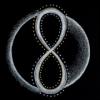 Submitted by Baal Shem on
Submitted by Baal Shem on

Derivative Images
There's an effect called the Troxler Effect that causes you to sometimes see monsters or deformation of your own face when you look into the mirror for a while.
The Troxler Effect is named after Swiss physician and philosopher Ignaz Paul Vital Troxler (1780-1866). In 1804, Troxler made the discovery that rigidly fixating one’s gaze on some element in the visual field can cause surrounding stationary images to seem to slowly disappear or fade. They are replaced with an experience, the nature of which is determined by the background that the object is on. This is known as filling-in.
The Troxler effect illustrates the importance of saccades, the involuntary movements of the eye which occur even while one’s gaze is apparently settled. If we could perfectly fixate on some point in our visual field by suppressing saccadic movement, a static scene would slowly fade from view after a few seconds due to the local neural adaptation of the rods, cones and ganglion cells in the retina. In brief, any constant light stimulus will cause an individual neuron to become desensitized to that stimulus, and hence reduce the strength of its signal to the brain.
When we attempt to fix our gaze on an object, the eye undergoes extremely rapid and relatively large-scale sudden movements called microsaccades, in contrast to saccadic drifts or small oscillations. Microsaccades cause the pattern of activity which forms the retinal image to shift across hundreds of photoreceptors at a time, providing a constant “refreshing” of the image (Martinez-Conde 2010). The Troxler effect occurs with any stationary stimulus, but it is particularly fast-acting and noticeable with low-contrast stimuli (so note the persistence of the cat’s grin, which is of higher contrast than the rest of the image). Such stimuli fail to trigger certain retinal mechanisms such as centre-surround ganglion cells which generate increased signal strength (see the entry on Adelson’s checkerboard illusion).
The term ‘filling-in’ has two usages in philosophy and vision science. Filling-in of an uncontroversial sort occurs when we experience something that is not directly given to us from sensory input. One example of this occurs when we look at the world with one eye. There is an area of the world that the eye receives no information about - the area from which the light that enters our eye falls on our blind spot. This is the area on the back of the eye that doesn't contain light-detecting cells. It is the area through which the optic nerve passes from the eye into the brain. (See the images of the retina and the eye below.)


When we look at the world with one eye we don't experience a gap in our visual field. Rather we experience something as being there - even if what we experience is illusory and consists of failing to see objects that are present. You can experience this for yourself by looking att the figures below. Close one of your eyes and look at the relevant pictures below while in front of and fixating on the cross. If you are at the right distance from the screen then you should stop experiencing the black dot. Rather you will experience a plain white background in the first two images. What gets filled-in at this spot depends on what surrounds that area. So in the third image, the red cross will disappear and you should experience the black line complete across the white gap.
Figure for demonstration of the disappearance of the black dot in the blind spot in the left eye

Figure for demonstration of the disappearance of the black dot in the blind spot in the right eye

Figure for demonstration of disappearance of the red cross and completon of the black line in the blind spot in the right eye

Another example of filling in occurs when retinally fixed stimuli fade due to neural adaptation. We can call these well-established phenomena experiential filling-in.
A more controversial kind of ‘filling-in’ is neural filling-in. This is posited as one explanation for the experiential filling-in described above. In neural filling-in the brain actively generates information which is triggered by an absence of information. For example possible neural explanation, discussed in Friedman et al. (2003), for explaining the watercolour illusion is that visual perception is based on a neural image operating as a 2-dimensional array, in which colour signals ‘diffuse’ in all directions until meeting a contour signal.
Philosopher and cognitive scientist Daniel Dennett has attacked the idea of neural filling-in (Dennett 1992), arguing that it presupposes a passive conscious observer embodied within the brain who is receiving information from the visual pathway as though viewing an image on a cinema screen (the homunculus fallacy). Dennett considers this picture to be false and to be inherent in any suggestion that there is a neural-perceptual isomorphism, which means a kind of (abstract) form-preserving map between the pattern of neural activity and the organized perceptual experience. Dennett (1991) makes the case that the neural substrate or basis supporting visual conscious experience is in fact distributed and transient in the brain. In short, experiential filling-in need not require neural filling-in.
However, Dennett's idea is highly controversial. See Myin and de Nul (2009) for a survey of experimental research suggesting that visual perceptions must indeed match neural activity isomorphically, and that neural filling-in does in fact take place.
Information and Images found @ https://www.illusionsindex.org/i/troxler-effect
Posted for educational purposes only.
References
Martinez-Conde, S., 2010. ‘Eye Movements During Fixation,’ in E. B. Goldstein (Ed), Sage Encyclopedia of Perception, London: Sage Publications, Inc, pp. 438-439.
Troxler, D., 1804. 'Über das Verschwinden gegebener Gegenstände innerhalb unseres Gesichtskreises' [On the disappearance of given objects from our visual field]. In Himly, K.; Schmidt, J.A. Ophthalmologische Bibliothek 2 (2): pp. 1–53.